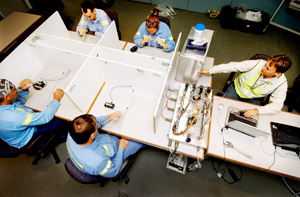Odour Testing & Chemical Speciation
Airlabs Environmental has successfully provided odour monitoring, testing and analysis services since 1995.
Odour Testing
The odour concentration (in Odour Units) of a stack gas or air sample is determined using Dynamic Olfactometry, a ‘dilution to threshold’ technique, in which the sample is presented to a trained panel of odour assessors at varying dilutions. This technique delivers directly comparable data for different odour types, and also provides input data for air dispersion models when determining odour impacts. This type of knowledge is invaluable when assessing odour complaints or preparing a development application.
Airlabs is NATA accredited in both the sampling and analysis of odour by Australian/ New Zealand Standard 4323.3, as well as for sampling of area sources (e.g. landfill surfaces, wastewater ponds and compost windrows) for odour impact assessment using the Flux Chamber Technique (AS/NZS 4323.4). In situations where the human perception of odour is also important in evaluating odour impacts, we offer odour intensity (perceived strength) and hedonic tone (degree of pleasure or displeasure) testing using the German VDI 3882 Guidelines, and field assessments of ambient air by VDI 3940.
Chemical Speciation
The ability to chemically speciate and quantify the diverse array of compounds present in air emissions is a necessary step towards efficient monitoring and control. We have various techniques available, including Gas Chromatography – Mass Spectrometry (GC-MS) and Proton Transfer Reaction - Mass Spectrometry (PTR-MS) to determine odorous species and environmentally significant volatile organic compounds in air and stack gas emissions.



